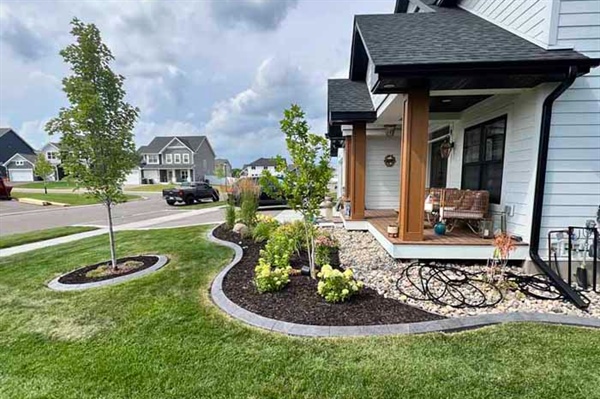Essentials of a Successful Landscape Design Plan

Designing a landscape that combines beauty, functionality, and durability requires careful planning and a keen attention to detail. Landscape design encompasses various elements, from selecting plants that offer year-round appeal to incorporating hardscaping features that enhance the space's look and feel.
At A-1 Curb Appeal, we believe effective landscape design is more than just aesthetics - it’s about creating natural spaces that are easy to maintain and withstand seasonal changes. A well-designed landscape not only boosts property value but also enhances outdoor enjoyment.
For those interested in crafting a lasting landscape, here are key insights into each process stage, from plant selection to balancing visual appeal and functionality.
How to Choose the Best Plants for Year-Round Appeal
Choosing plants that provide year-round appeal is essential in landscape design, especially in climates with distinct seasons. Plants should be selected based on their bloom times, foliage colors, and seasonal transitions to ensure the landscape remains lively.
For instance, incorporating evergreens, flowering shrubs, and perennials can add color and structure across the seasons.
Evergreen plants are popular as they maintain their foliage throughout the year, offering green hues during colder months when many other plants go dormant. Deciduous trees and shrubs with vibrant autumn foliage add seasonal interest, while spring bulbs bring early color to the landscape.
The right mix creates a dynamic and evolving garden that feels engaging year-round.
When planning, consider professional landscape design services to help with plant selection and ensure they match your environment’s conditions and personal preferences.
What Role Does Soil Quality Play in Design Success?
Soil quality is a fundamental aspect of landscape design that directly impacts plant health and growth. Soil provides the necessary nutrients and support for plants, and its composition affects water drainage and root establishment.
Poor soil quality can lead to drainage and nutrient deficiency issues, affecting plant resilience and appearance.
A soil test can reveal the pH level and organic matter content, helping identify necessary amendments.
For example, soils that are too acidic or alkaline may hinder plant growth, requiring adjustments to improve conditions. Adding compost or organic matter can boost soil structure, aiding in water retention and root support.
How Do Hardscaping Elements Impact Design Flow?
Hardscaping elements like pathways, patios, and retaining walls are more than just functional features - they guide the flow of the landscape and create structure. A well-planned hardscape enhances accessibility, encourages exploration, and integrates different areas into a cohesive design.
Materials such as stone, concrete, and pavers can create visually appealing and practical pathways that complement the garden’s natural beauty.
Retaining walls serve multiple purposes, from managing slopes to adding texture and depth to the design. Steps, terraces, and seating areas can make the landscape inviting while also accommodating natural features like slopes and water elements.
Choosing materials that match the overall design style helps ensure continuity and harmony.
These elements create defined spaces and improve usability, making landscapes enjoyable for years.
What Factors Go into Planning for Natural Drainage?
Natural drainage planning is crucial to prevent water pooling, erosion, and plant damage. Proper drainage protects plants and hardscaping features from water damage, especially in areas with high rainfall.
Understanding the site’s topography allows designers to identify potential drainage paths and low-lying areas that may require intervention.
Common solutions include installing French drains, rain gardens, or swales to redirect water flow. Permeable pavers can also help manage runoff by allowing water to soak into the ground rather than pooling.
These methods help maintain soil stability and reduce erosion, ensuring the landscape remains resilient and aesthetically pleasing.
A professional approach to drainage can safeguard the design’s integrity and longevity in areas prone to heavy rainfall.
How to Balance Functionality with Aesthetics in Design
Balancing functionality and aesthetics is key to creating a beautiful and practical landscape. Functional elements like seating, lighting, and pathways make outdoor spaces usable, while plant arrangements and hardscaping features enhance the visual appeal.
The challenge lies in seamlessly blending these elements to serve the landscape's intended purpose without compromising style.
Choosing versatile plants and incorporating multi-use spaces allows the landscape to adapt to various needs, from hosting gatherings to offering quiet relaxation spots.
Strategic placement of plants and structures can frame views, highlight focal points, and provide shade or privacy, adding comfort and functionality.
Create a Beautiful Landscape Design with A-1
With a thoughtful design approach, landscapes can be stunning and practical, allowing homeowners to enjoy an outdoor space that meets aesthetic and functional needs.
A-1 Curb Appeal brings expertise to every project for tailored solutions, ensuring your landscape achieves this essential balance. From patio design to seasonal lawn care, our team of experts can create the perfect finish for your property.
If you need assistance with any of these essential elements of landscape design, contact us to explore expert design solutions for your unique space.